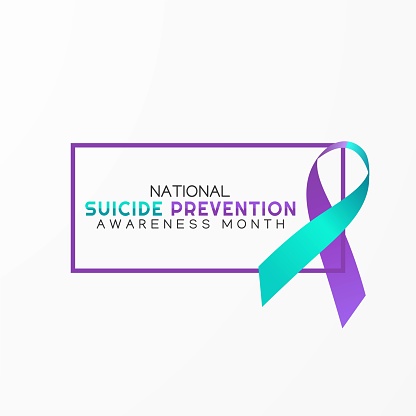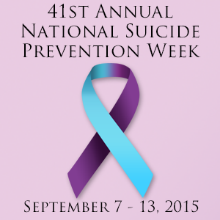Recognizing National Suicide Prevention Awareness Month
Every September, mental health advocates, prevention organizations, community members, peers, and survivors join together for National Suicide Prevention Awareness Month to help raise awareness of a problem that has led to more than 40,000 deaths last year in America.
Like many other conditions, suicidal ideation is relatively common but is rarely discussed due to an unfair stigma that surrounds the topic. One of the goals of National Suicide Prevention Awareness Month is to remove that stigma and enable people to ask if their friends and loved ones are experiencing suicidal ideation so they can discuss their feelings without judgment.
Research has shown that people who are thinking about suicide feel relieved when they are asked about it in a caring way. Findings suggest that acknowledging suicidal thoughts decreases a person’s risk of suicide, rather than increasing it.
Raising awareness
In addition, National Suicide Prevention Awareness Month is a time to inform the public about some of the facts about suicide in America: Here are some of the facts and figures that the National Alliance on Mental Health, has publicized on its website.
• 78% of all people who die by suicide are male.
• Although more women than men attempt suicide, men are nearly 4x more likely to die by suicide.
• Suicide is the 2nd leading cause of death among people ages 10 to 34 and the 10th leading cause of death overall in the U.S.
• The overall suicide rate in the U.S. has increased by 35% since 1999.
• 46% of people who die by suicide had a diagnosed mental health condition.
• While nearly half of individuals who die by suicide have a diagnosed mental health condition, research shows that 90% experienced symptoms.
• Lesbian, gay and bisexual youth are 4x more likely to attempt suicide than straight youth.
• Transgender adults are nearly 12x more likely to attempt suicide than the general population.
One of the best resources available for people experiencing suicidal ideations is the National Suicide Prevention Lifeline, (1-800-273-8255), a 24-hour confidential and anonymous service for individuals to discuss how they are feeling with trained call-takers. The Lifeline is working to focus on ways people can help those they care about.
According to the NSPL, one of the best ways to help is to simply be there and listen to someone speak about suicide without judgment. Their message during National Suicide Prevention Month is #BeThe1To as in: be the one to be there for someone in need.
Legal help is available
Despite all efforts at prevention, too many people continue to lose loved ones to suicide completion. The Law Offices of Skip Simpson has the experience and knowledge to investigate the circumstances of suicide and advise families on how to proceed during an extraordinarily difficult time. Although our law firm is based in Texas, we serve clients nationwide, so if you have suffered the loss of a loved one, contact attorney Skip Simpson today to learn more about your legal rights and options.







 A
A  Mental health facilities have obligations to psychiatric patients to keep them safe, particularly when patients are on suicide watch and there is a risk of death by suicide. One of the duties in most facilities is simply to monitor patients who are at great risk to ensure they do not try to self-harm. If a hospital has failed in any of its obligations to patients and inpatient suicide occurs as a result of this failure, it is possible to take legal action against the facility.
Mental health facilities have obligations to psychiatric patients to keep them safe, particularly when patients are on suicide watch and there is a risk of death by suicide. One of the duties in most facilities is simply to monitor patients who are at great risk to ensure they do not try to self-harm. If a hospital has failed in any of its obligations to patients and inpatient suicide occurs as a result of this failure, it is possible to take legal action against the facility. Approximately six percent of deaths by suicide in the United States occur when patients are under care in a psychiatric hospital, a mental health facility, or a mental health unit of a hospital. According to
Approximately six percent of deaths by suicide in the United States occur when patients are under care in a psychiatric hospital, a mental health facility, or a mental health unit of a hospital. According to  A new school year is starting and kids will soon be heading back to college campuses nationwide. For many of these students, the new school year is not something to look forward to this fall. Instead, returning to college mean means a return to the tremendous pressures to be perfect in a competitive college setting. High expectations and intense stress to succeed often contribute to high rates of campus depression and suicidal thoughts among young people.
A new school year is starting and kids will soon be heading back to college campuses nationwide. For many of these students, the new school year is not something to look forward to this fall. Instead, returning to college mean means a return to the tremendous pressures to be perfect in a competitive college setting. High expectations and intense stress to succeed often contribute to high rates of campus depression and suicidal thoughts among young people.
 When someone is having thoughts of suicide, a psychiatric hospital should be a place where they are kept safe: it is the reason for they exist. Psychiatric hospitals must ensure their facilities provide no opportunity for patients to cause themselves harm when they are at risk of
When someone is having thoughts of suicide, a psychiatric hospital should be a place where they are kept safe: it is the reason for they exist. Psychiatric hospitals must ensure their facilities provide no opportunity for patients to cause themselves harm when they are at risk of 
